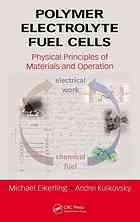”The book provides a systematic and profound account of scientific challenges in fuel cell research. The introductory chapters bring readers who have a scientific background, but who are not experts in electrochemical energy conversion, up to date on the urgency and implications of the global energy challenge, the prospects of electrochemical energy conversion technologies, and the thermodynamic and electrochemical principles underlying the operation of polymer electrolyte fuel cells. The book then presents the scientific challenges in fuel cell research as a systematic account of distinct components, length scales, physicochemical processes, and scientific disciplines. The main part of the book focuses on theory and molecular modeling. Theoretical tools and approaches, applied to fuel cell research, are presented in a self-contained manner. Chapters are arranged by different fuel cell materials and components, and sections advance through the hierarchy of scales, starting from molecular-level processes in proton conducting media or electro catalytic systems and ending with performance issues at the device level, including electrochemical performance, water management, durability and analysis of failure mechanisms. Throughout, the book gives numerous examples of formidable scientific challenges as well as of tools to facilitate materials design and development of diagnostic methods. It reveals reserves for performance improvements and uncovers misapprehensions in scientific understanding that have misled or may continue to mislead technological development. An indispensable resource for scientifically minded and practically oriented researchers, this book helps industry leaders to appreciate the contributions of fundamental research, and leaders of fundamental research to appreciate the needs of industry”–
”Preface More than 175 years have passed since the discovery and first demonstrations of the fuel cell principle by Christian Friedrich Schoenbein and Sir William Grove. However, in spite of many years of research, fuel cells still are somewhat exotic and seemingly unaffordable power sources. The main reasons are materials cost and a lack of fundamental knowledge of fuel cell operation. In this book, we discuss low-temperature fuel cells with a polymer electrolyte membrane (PEM). Two main representatives of the family of low-T cells are hydrogen-fed polymer electrolyte fuel cells (PEFCs) and liquid-fed direct methanol fuel cells (DMFCs). Though the major part of this book is devoted to materials and performance modeling of PEFCs, some features of DMFCs will also be discussed due to a great potential of these cells for small-scale mobile applications. Noting that PEFCs are highly efficient and environmentally friendly power sources is a commonplace. The only chemical product of the fuel cell reaction is water; the exhaust contains neither carbon dioxide nor toxic oxides, water’s evil twin products from the combustion of fossil fuels. In contrast to internal combustion engines (ICEs), fuel cells produce no noise. Another advantage of fuel cell systems is simplicity; they are much simpler than ICEs. When opening the cowling of an ICE car, a lot of pipes are seen. In an FC system, numerous pipes are invisible, as they are of a nanoscale size”– Read more…
Physical
{pdf} Polymer Electrolyte Fuel Cells: Physical Principles of Materials and Operation Michael Eikerling; Andrei A Kulikovsky
$19.99






Reviews
There are no reviews yet.